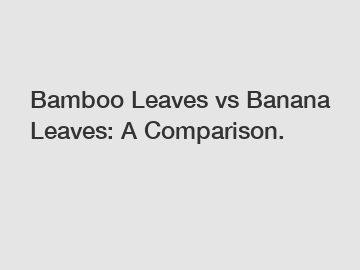Bamboo Leaves vs Banana Leaves: A Comparison.
### Bamboo Leaves vs Banana Leaves: A Comparison.
**Q1: What are the similarities between bamboo leaves and banana leaves?**.
Both bamboo leaves and banana leaves are commonly used in Asian cuisine for wrapping food. They are natural, biodegradable materials that add a unique flavor and aroma to dishes. Additionally, both types of leaves are versatile and can be used in various cooking methods such as steaming, grilling, and baking.

**Q2: What are the differences between bamboo leaves and banana leaves?**.
Bamboo leaves are thin and flexible with a subtle, grassy flavor, while banana leaves are larger and thicker with a more pronounced, earthy taste. Bamboo leaves are often used for delicate dishes like zongzi, a traditional Chinese rice dumpling, while banana leaves are preferred for more robust flavors like grilled meats or fish.
### Bamboo Leaves.
Bamboo leaves are commonly used in Asian cuisine, particularly in Chinese and Vietnamese cooking. They are prized for their delicate texture and subtle flavor, which adds a unique touch to dishes. Bamboo leaves are often used to wrap sticky rice dumplings, known as zongzi, during the Dragon Boat Festival. They are also used to wrap other savory or sweet fillings for steaming or baking.
Bamboo leaves can be found fresh or dried, with the dried leaves requiring soaking before use. They are typically washed and trimmed before being filled with the desired ingredients. The leaves help to infuse the food with a fragrant, herbal aroma while also imparting a grassy flavor. Bamboo leaves are not edible and are removed before serving.
### Banana Leaves.
Banana leaves are larger and more robust compared to bamboo leaves. They are commonly used in Southeast Asian and Indian cuisine for wrapping various dishes before cooking. Banana leaves are known for their earthy flavor, which adds a distinctive taste to grilled or steamed foods.
Similar to bamboo leaves, banana leaves need to be washed and trimmed before use. They are often used to wrap meats, fish, or rice dishes for grilling or steaming. The leaves help to keep the food moist and impart a subtle, tropical aroma to the dish. Banana leaves are also not meant to be eaten and should be removed before serving.
In conclusion, while bamboo leaves and banana leaves both have their unique characteristics, they are both versatile and add a special touch to dishes. Whether you prefer the delicate flavor of bamboo leaves or the earthy taste of banana leaves, both types of leaves can elevate the presentation and taste of your culinary creations.
Contact us to discuss your requirements of Dried Bamboo Leaves manufacturer, Bamboo Leaves For Japanese Restaurants, Dried Bamboo Leaves for Australia. Our experienced sales team can help you identify the options that best suit your needs.
214
0
0

Comments
All Comments (0)